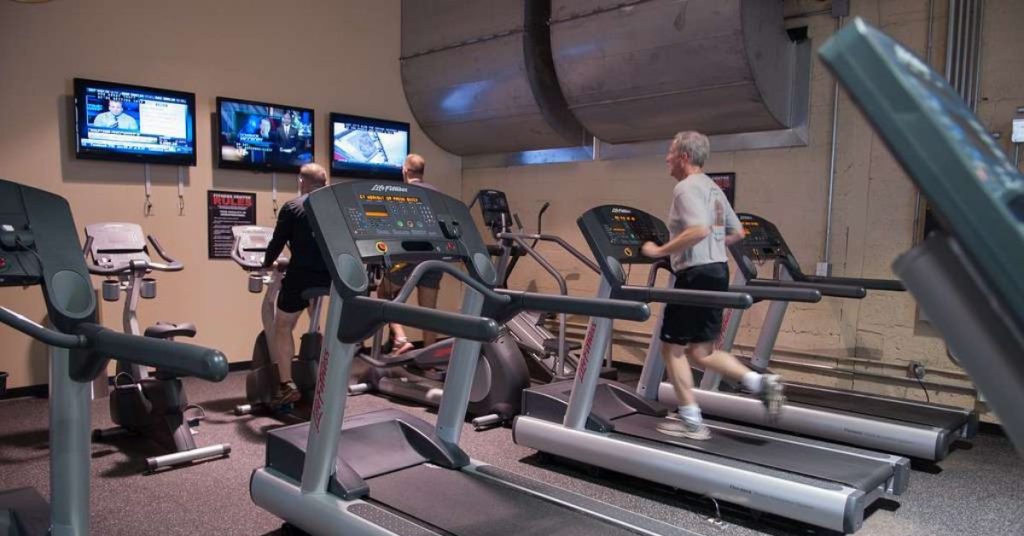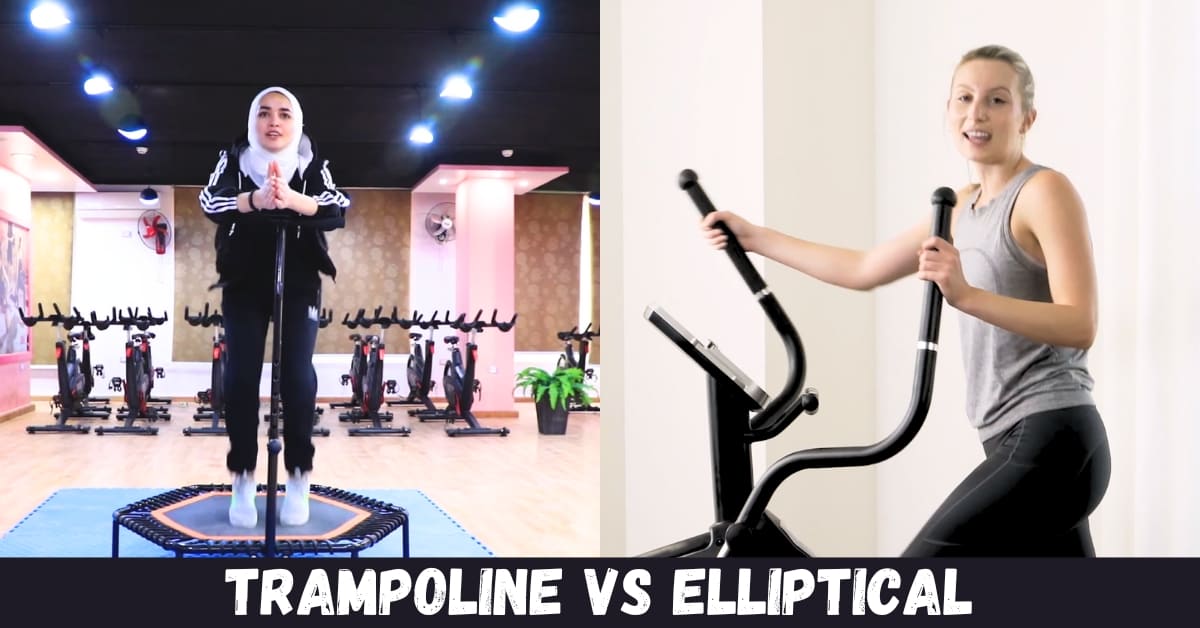I’ve always relied on it for my stationary cardio workouts. It has consistently proven to be superior to other exercise machines in terms of its numerous benefits.
However, recently, I’ve observed a surge in the popularity of trampolines as an exercise method. No longer limited to being a source of entertainment for energetic kids, personal trampolines have become a common sight in both home and gym settings.
In fact, some fitness centers now offer trampoline classes alongside traditional elliptical and spinning cardio workouts. I’m genuinely intrigued to compare and contrast the trampoline vs elliptical to understand how they stack up against each other.
Trampoline Vs Elliptical: An elliptical workout can burn approximately 575 calories per hour while jumping on a trampoline for the same duration only burns around 290 calories.
Trampolines

Trampolines have become increasingly popular as a form of exercise and recreation. They consist of a strong, flexible fabric stretched tightly over a steel frame with coiled springs, allowing users to bounce and jump on a springy surface.
Trampolines offer a range of health benefits, including improved cardiovascular fitness, increased lymphatic circulation, and enhanced balance and coordination. They provide a fun and engaging way to exercise, suitable for people of different ages and fitness levels.
Trampolines come in various sizes, from mini-trampolines for indoor use to larger outdoor trampolines designed for backyard use. While trampolines offer numerous advantages, using them safely and following proper guidelines to avoid injuries is essential.
Ellipticals:

Ellipticals are exercise machines that simulate walking, running, or stair climbing. They feature pedals that move in an elliptical or oval-shaped path and handlebars for upper-body engagement.
With adjustable resistance levels and built-in consoles to track metrics, ellipticals offer a range of health benefits. They provide a low-impact cardiovascular workout, elevating heart rate while reducing joint stress.
The combined upper and lower body movements engage multiple muscle groups, improving muscle tone, strength, and endurance. Ellipticals offer convenience, customizable intensity levels, and a smooth motion that minimizes strain and the risk of impact-related injuries.
However, maintaining proper form and considering individual fitness goals are crucial when using ellipticals.
Exercise with low Impact has many Benefits.
Both rebounders and elliptical trainers offer joint-friendly workouts, minimizing the impact on knees, hips, ankles, and the spine compared to running. However, a drawback is the absence of weight-bearing exercise, which is important for preventing osteoporosis.
Both options provide versatile exercise routines that engage multiple muscles. The elliptical enables pedaling in reverse, targeting the hamstrings and calf muscles, while the movements on a rebounder include activities like running in place, jumping, and lifting knees, working both the quads and glutes.
Cardiovascular Benefits
Both rebounders and elliptical trainers offer effective workouts for cardiovascular health. According to the American College of Sports Medicine, rebounding meets the guidelines for improving cardiorespiratory fitness. Jumping on a rebounder can stimulate the heart and provide a cardio workout.
On the other hand, elliptical machines allow for increased resistance and incline, intensifying the lower-body workout and building muscle strength while elevating the heart rate as needed.
Additionally, elliptical trainers feature handles that simulate movements like cross-country skiing, engaging the upper body for a more comprehensive workout. Many elliptical machines also come equipped with heart rate monitors, making it easy to monitor and maintain the target heart rate zone for optimal cardiovascular health.
User-Friendly Design

Mini trampolines often come with fold-up or detachable legs, allowing for easy storage under a bed or in a closet.
They can be conveniently placed in front of a TV or set up outdoors on a flat surface. In contrast, elliptical machines tend to be large and require dedicated space in a workout room or a visit to the gym.
Cost is also a factor to consider. Premium elliptical machines can exceed $1,000 in price, while rebounders can be purchased for as low as $40, making them a more budget-friendly option.
Enhanced Stability
Elliptical trainers provide added safety features in the form of handrails or poles, making them a suitable choice for individuals with balance concerns.
On the other hand, while stabilizing bars can be purchased for rebounders to provide support, they can sometimes feel awkward and limit the potential cardiovascular benefits.
It’s important to note that starting a fitness routine on an elliptical machine may not always be effortless. Therefore, it is highly recommended that individuals with stability issues invest in an elliptical trainer equipped with handrails to ensure enhanced stability during workouts.
Fitness Options for Adults with Physical Challenges
Elliptical machines are significantly more suitable than trampolines for accommodating physical challenges and impairments. Ellipticals can be adapted for use by disabled or partially disabled individuals by adding steps, deeper footbeds, and side rails.
On the other hand, trampolines cannot be modified similarly due to their simple design. So, which option is better for a comprehensive cardio workout? The elliptical machine usually takes the lead.
It provides a versatile and accessible exercise experience, although trampolines are still excellent in their own right. The elliptical’s adaptability and range of features make it the preferred choice for individuals seeking a well-rounded fitness routine.
Creating a Home Fitness Space
Both trampolines and elliptical machines are valuable additions to a home gym, offering cardio and weight-bearing exercises. However, before making a purchase, a few factors must be considered.
Firstly, assess your budget and the available space in your home gym, including both floor space and ceiling clearance. Trampolines come in various sizes, including portable rebounders used in fitness classes, which are more cost-effective than new or used elliptical machines.
Conversely, Ellipticals are larger, heavier (weighing over a hundred pounds), and harder to move. Both machines require sufficient clearance for safe use, with ellipticals needing more floor space and trampolines requiring adequate ceiling clearance.
It is crucial to ensure that if you opt for a trampoline, you have enough headroom to avoid any collisions with the ceiling during your workouts.
Trampoline Vs Elliptical: Comparison of Features
Here is the comparison of features between the trampoline and vs elliptical:
Size and Portability:
- Trampoline: Trampolines come in various sizes, from small portable rebounders to larger ones. Portable rebounders are lightweight and easy to move, making them suitable for limited spaces or for those who prefer flexibility.
- Elliptical: Elliptical machines are typically larger and heavier than trampolines. They are less portable and require dedicated space in a home gym or workout area.
Exercise Variety:
- Trampoline: Trampolines offer a wide range of exercises, including jumping, bouncing, and running in place. These activities engage various muscle groups and provide a dynamic and fun workout experience.
- Elliptical: Elliptical machines offer versatile workout options, allowing users to adjust resistance levels, incline, and even pedal in reverse. They provide a full-body workout that targets the legs, arms, and core.
Impact on Joints:
- Trampoline: Trampoline workouts are generally high-impact, which can stress the joints, particularly the knees, hips, and back. Individuals with joint issues or injuries should exercise caution and consult a healthcare professional before using a trampoline.
- Elliptical: Elliptical machines provide a gentle, low-impact workout on the joints. The elliptical motion minimizes stress on the knees, hips, and back, making it a suitable option for individuals with joint sensitivities or those recovering from injuries.
Cost:
- Trampoline: Trampolines, especially portable rebounders, are generally more affordable than elliptical machines. The cost can vary depending on the size and quality of the trampoline.
- Elliptical: Elliptical machines can range in price, with higher-end models often costing more than $1,000. More budget-friendly options are also available but may not have as many advanced features.
Accessibility for Different Fitness Levels:
- Trampoline: Trampolines can be adjusted to accommodate different fitness levels, allowing individuals to modify the intensity of their workouts based on their abilities and preferences.
- Elliptical: Elliptical machines offer adjustable resistance levels, making them suitable for users of various fitness levels. Beginners and advanced exercisers can both benefit from using an elliptical by adjusting the intensity to match their needs.
It’s important to consider these features, and how they align with your fitness goals, preferences, and any specific considerations or limitations you may have.
Considerations for Choosing
Here are the consideration for choosing a trampoline or an elliptical:
Fitness Goals:
- Determine your fitness goals and what you aim to achieve through your workouts. Are you primarily focused on cardiovascular endurance, muscle toning, weight loss, or overall fitness improvement?
- Consider which exercise option aligns better with your specific fitness goals. For example, the elliptical may be more suitable if you prioritize low-impact workouts. In contrast, the trampoline could be a better choice if you prefer a dynamic and engaging workout experience.
Physical Condition and Injuries:
- Assessing current physical health and limitations
- Consulting with a healthcare professional if there are pre-existing injuries or medical conditions
- Determining which option is safer and more suitable for the individual’s physical condition
Space Availability:
- Evaluate the available space in your home or workout area. Measure the dimensions and consider the ceiling height, as trampolines require adequate overhead clearance.
- Determine if you have enough space to accommodate the size and storage needs of the chosen equipment. Trampolines may require more floor space, while ellipticals may need a dedicated corner or area.
Joint Sensitivity or Injury History:
- Assess your joint health and any previous or existing injuries. If you have joint sensitivities or are recovering from joint-related injuries, a low-impact option like the elliptical may be preferable.
- Consult with a healthcare professional if you have concerns about the impact on your joints and seek their advice on the most suitable exercise option for your specific condition.
Budget:
- Consider your budgetary constraints and determine how much you will invest in your exercise equipment.
- Research and compare trampolines’ and elliptical prices to find options that fit your budget while still meeting your needs.
Personal Preferences:
- Consider your personal preferences and what type of exercise you enjoy. Consider which option will likely keep you motivated and engaged in your workouts.
- Reflect on your past experiences with each exercise method, if any, and consider which one you find more enjoyable and sustainable in the long run.
Considering these factors, you can make an informed decision and choose the exercise option that best aligns with your goals, space availability, joint health, budget, and personal preferences.
Related article: What Size Trampoline for 2 Kids
FAQs:
Q:1 Which equipment provides a more effective cardiovascular workout, a trampoline or an elliptical?
Both trampolines and ellipticals offer effective cardiovascular workouts. However, ellipticals typically allow for higher intensity and greater resistance options, making them slightly more efficient in terms of calorie burn and cardiovascular conditioning.
Q:2 Are trampolines suitable for individuals with joint issues or injuries?
Trampolines can stress the joints, especially the knees, and hips, making them less suitable for individuals with joint issues or injuries. The low-impact nature of ellipticals makes them a better option for those seeking a gentler workout that minimizes joint strain.
Q:3 Do trampolines or ellipticals help with weight loss?
Both trampolines and ellipticals can contribute to weight loss when incorporated into a consistent exercise routine. Both equipment’s calorie burn and cardiovascular benefits can support weight loss goals.
Q:4 Can trampolines or ellipticals help improve balance and coordination?
Trampolines are known for their ability to improve balance and coordination due to the requirement of maintaining stability while jumping. Ellipticals, on the other hand, primarily focus on cardiovascular conditioning and do not provide the same emphasis on balance and coordination.
Q:5 Which equipment offers a more versatile workout experience?
Ellipticals generally offer more versatility in terms of workout options. They often include adjustable resistance levels, incline settings, and built-in workout programs.
Trampolines, while versatile in terms of movements, may have limited exercise variety compared to ellipticals.
Q:6 Are trampolines or ellipticals suitable for people with physical disabilities or limitations?
Ellipticals are generally more accessible for individuals with physical disabilities or limitations. They can be adapted with additional features like handrails and deeper footbeds to accommodate those with balance or mobility issues. Trampolines, due to their design, are less adaptable and may not be suitable for certain physical challenges.
Q:7 What are the space requirements for trampolines and ellipticals?
Trampolines require ample floor space and sufficient ceiling clearance, especially for larger models. Ellipticals, while typically more compact, still require a designated area with enough room for proper movement and access to the equipment.
Conclusion:
In Conclusion, both trampolines and ellipticals have their own advantages and considerations. Trampolines offer a fun and dynamic workout, promoting cardiovascular fitness, balance, and coordination. However, they may not be suitable for individuals with joint issues or injuries due to their high-impact nature.
On the other hand, ellipticals provide a low-impact workout that is gentle on the joints, making them a favorable option for individuals seeking cardiovascular exercise with reduced strain.
When deciding between a trampoline and an elliptical, it is important to consider factors such as the target audience, space requirements, cost, and additional features.
Each piece of equipment caters to different needs and preferences. Consulting with a fitness professional or healthcare provider can help determine the best choice based on individual circumstances.
Ultimately, both trampolines and ellipticals can contribute to a healthy and active lifestyle. Choosing the equipment that aligns with personal fitness goals and supports overall well-being is essential.
After reading this comprehensive article, we hope you will be well aware of trampoline vs elliptical. If you have any questions, feel free to comment below!

